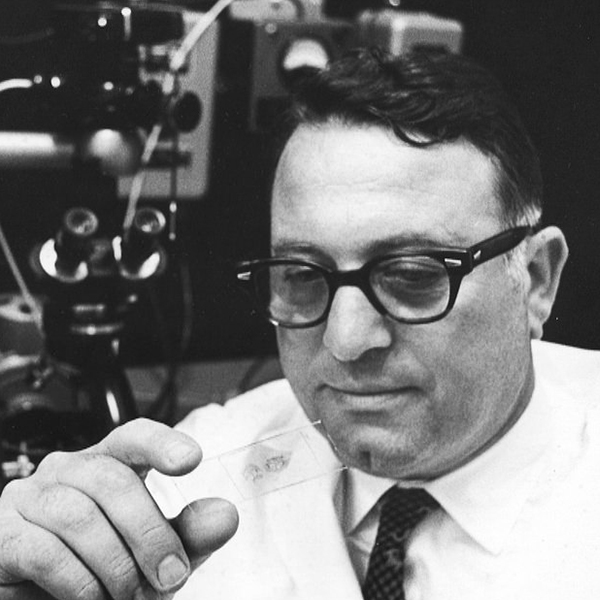
Meeting Society's Needs
In addition to providing Californians the opportunity for professional education, the push to open a veterinary school in 1948 was also justified by a need to address serious disease problems in California's agricultural industries, for example, screw-worm in livestock, encephalomyelitis in horses and brucellosis in cattle.
Pioneering faculty developed the first intradermal skin test for bovine tuberculosis, a zoonotic disease, that helped the US reduce bovine TB to less than two-tenths of one percent.
Vaccine testing, diagnostic tools and disease research helped California achieve brucellosis-free status and became the standard for testing and immunization in the US and other countries. Brucellosis is highly contagious and can be transmitted to humans.
The opening of the Veterinary Medical Teaching Hospital in 1970 marked a new era in veterinary care for companion animals and continues to meet client demand for the most sophisticated care options available for their animals.
To serve the Thoroughbred racing industry and protect equine welfare, the school's Center for Equine Health, Kenneth L. Maddy Equine Analytical Chemistry Laboratory, JD Wheat Veterinary Orthopedic Research Laboratory and the California postmortem program have provided drug testing of racehorses, identified factors involved in catastrophic injury in horses, and alerted the racing community about how equine injuries at the track place jockeys at risk for injury.
For oil spill response throughout California and consulting abroad on environmental health concerns, the Oiled Wildlife Care Network has served the state since 1994. The network's research added to knowledge about treatment and long-term survival of oiled wildlife, including birds, marine mammals and sea turtles. School personnel have developed rehabilitation protocols and met urgent needs for expertise after oil spill events in Louisiana, New Zealand, Japan and other locations.
When a disaster strikes such as fire, flood or earthquake, evacuees face the difficult decision whether to leave their animals behind, sometimes putting themselves and rescuers alike at risk. For nearly two decades, veterinary faculty have advocated for and participated in statewide policy development to incorporate animals into emergency response planning protocols. The International Animal Welfare Training Institute has trained dozens of first-responders from California counties how to identify appropriate temporary facilities for rescued livestock, respond to quickly to downed animals (whether on farm or freeway), move injured animals safely, conduct airlift rescues and prepare animal owners for emergencies.
Meeting society's needs has involved technology transfer from the university into the field. New diagnostic testing tools and vaccine technology have benefited animal health and agricultural livelihoods. Since the 1990s, faculty of the International Laboratory for Tropical Disease Research have trained scientists from developing countries in biomedical techniques and helped set up laboratories to improve recombinant vaccines and diagnostic kits suitable for use under field conditions. Such efforts have been applied successfully to control rinderpest, peste des petits ruminants and vesicular stomatitis. Large animal veterinary faculty have shared management tools with dairy producers in Mexico, China and Africa.
The Koret UC Davis Shelter Medicine Program pioneered novel approaches to the unique problems faced by animal shelters throughout the US. The school initiated the first shelter medicine residency to provide specialized expertise in infectious diseases and behavioral issues of shelters; established an Extension veterinarian; responded to outbreaks; designed shelter facilities to optimize health; and provided education about responsible ownership of companion animals.
To assure that the profession would meet the needs of California's diverse population, the Summer Enrichment Program launched its first effort in 1987 to prepare prospective DVM applicants who were overcoming educational, cultural, financial or physical disadvantages. About half of participants entered a Doctor of Veterinary Medicine program. As of 2015, the school ranks third in the nation for veterinary student diversity, with 29 percent of the student body from traditionally under-represented groups. As of 2015, the school began a cultural competency training program for faculty, students and staff. The students themselves launched an organization to celebrate multiculturalism in veterinary medicine and mentor pre-veterinary students.
From the basics of scientific observation and microbe testing to the sophistication of DNA analysis, veterinary scientists have served the needs of agriculture, food safety and veterinary public health. For example, as of 2015, the 100K Genome Project has sequenced 1,500 genomes of microbes. By identifying the genetic structures of Salmonella, E. coli and other foodborne pathogens, the world can limit the spread of such microorganisms, protect food safety and improve animal health.
As society's needs grow ever more complex and far-reaching, veterinary medicine's involvement in animal, human and environmental health is more important than before, and the School of Veterinary Medicine's commitment is stronger than ever.
